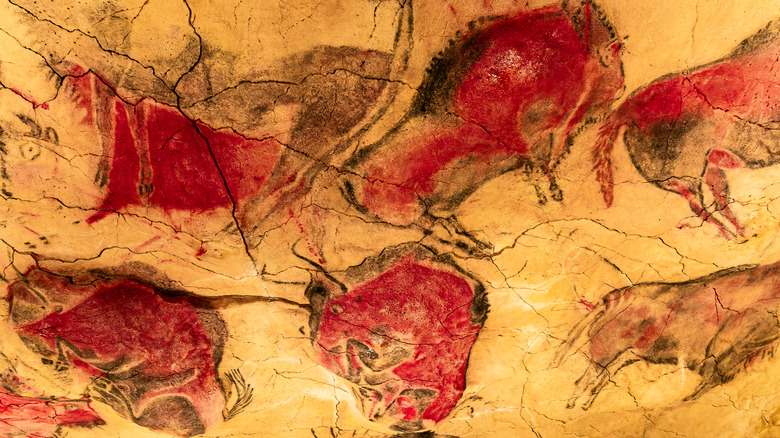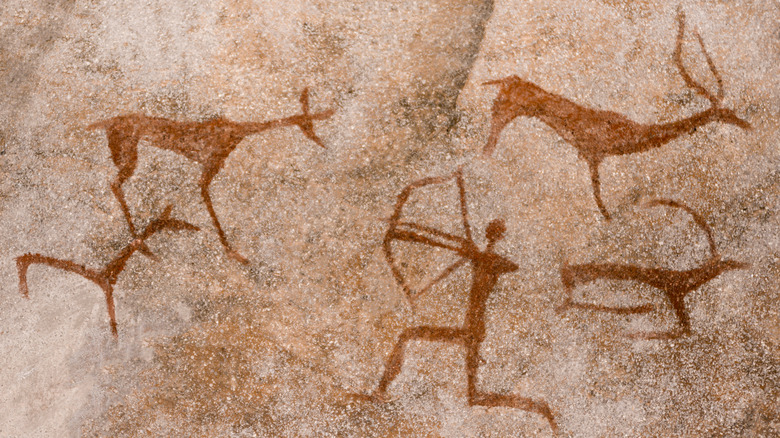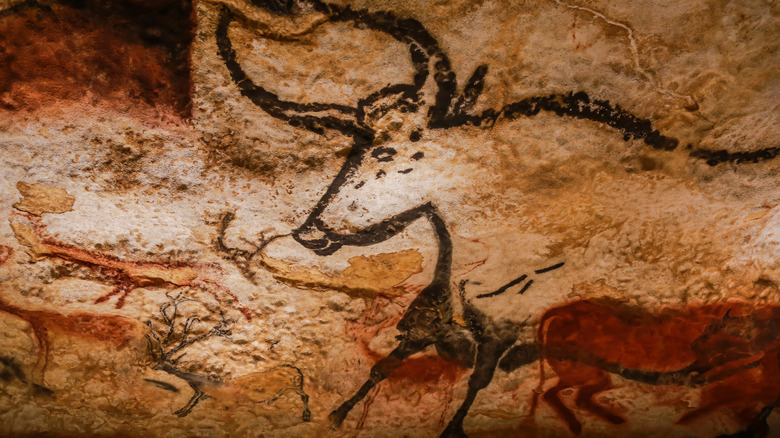The Speculated New Meaning Behind Ice Age Cave Art
The year is 40,000 B.C.E. There is no social media, which is excellent. There is also no music beside Grok the hunter's terrible voice and Thak the gatherer's clacking of two stones. There are no supermarkets, which is extremely inconvenient but good for your budget. There is no agriculture whatsoever, so if you want a carrot, you've got to rove the forest to find one and dig it up. The easiest way to survive is to do what your ancestors have done for hundreds of thousands of years: find another animal, kill it, and ingest it. This is your raison d'être — your reason for existence. There is only food, shelter, and yes, probably lots of procreation (but be honest: the food comes first).
So is it any wonder why cave art always depicts animals? We've got bulls, pigs, horses, cats, bears, and even rhinoceroses in a cave in modern-day southwest France, as the Bradshaw Foundation says. There's no more megafauna like rhinos in Europe, though, or giant kangaroos in Australia, per Big Think. As The Conversation explains, humans killed and ate them all (and changes to climate helped). What's the lesson here? Never underestimate the power of hunger. Also remember that human and animal life are interwoven in the deepest, most fundamental ways. Case in point: a fresh take on the lines, dots, and symbols found in certain cave art. As Science New explains, such markings might be an early form of record-keeping meant to track animal reproduction.
A prehistoric prey dossier
Why exactly would it matter to hunter-forager humans when local boars went out on date night and produced little boarlets? Little boarlets equal more food for the clan. Also, animals become more aggressive during mating season and might need to be avoided, like brutally aggressive bucks (per The British Deer Society). Maybe mothers of newborns also need to be avoided because they become savagely violent to protect their blind and helpless young, like mountain lions (per Glacier National Park). Perhaps in certain seasons certain types of animals are especially vulnerable or hard to find. Maybe there's a tradeoff of risk and reward for a variety of animals across various seasons. And in the absence of an Excel spreadsheet, you know what might be useful to track all this data? Some hash marks on a cave wall next to a picture of an animal, like a prehistoric prey dossier.
Lo and behold, this is exactly what people like researcher Ben Bacon say on Science News, per a study published on Cambridge University Press. Bacon talks about three prominent symbols in association with certain cave drawings: a vertical line, a dot, and a "Y" shape. Several lines in a row, for instance, aren't an indicator of tallies, he says — e.g., five lines meaning five bears. Rather, the markings indicate an ordinal system: first, second, third, etc. And when a Y pops up? That means it's the time of the year for an animal to give birth.
Synced to snowmelt
The recent study and its conclusions don't come from one cave, but an analysis of 400 caves in modern-day France, such as Lascaux, Chauvet, and Altamira caves, as Cambridge University Press describes. All of these sites date to the same time range, from about 40,000 to 35,000 B.C.E. This means that notations like the line, dot, and Y, if they're indeed what Ben Bacon thinks they are, were used for at least 5,000 years. That's longer than the time from the present day back to when the Pyramids at Giza were built from 2550 to 2490 B.C.E., per National Geographic. The notations aren't seen around the world, however, indicating that they're a regional system shared amongst related peoples.
The symbols themselves seem to be connected to cycles of the moon. This makes sense, as the moon makes a regular, easy-to-use calendar provided folks just look up at the night sky. The dots, as Science News explains, might correspond to moon cycles, like the first moon cycle, second, third, and so on. The presence of a Y indicates that it's an animal's birthing cycle. As for when such a calendar would start, it's unlikely that people of that time would have tracked time using specific celestial events like the autumnal equinox. Rather, it's believed they used snowmelt to kick off the calendar, with the first month following the thaw of winter and transition to spring. This system would have had the added advantage of being used in any location.


